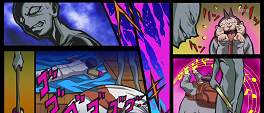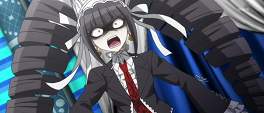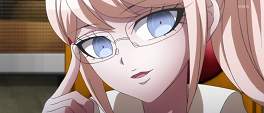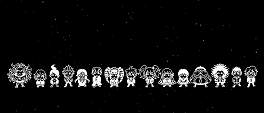The Dangan Ronpa anime accrues a lot of pop-culture debt during its thirteen episode run. The most obvious being to Phoenix Wright (Gyakuten Saiban) with its near carbon copy of the hyperactive trials, only the iconic “Objection!” being replaced with a bizarre ammunition mechanic. More surreptitiously is its desire to be even a fraction as stylish as Persona 4 with a funky-smooth Engrish opening and questionably bold style. Tertiary influences seem to include the torturous logic diatribes from Death Note as well as the “children versus children” storyline from Battle Royale (and by extension the recent BTOOOM among others).
Combine these with a day-glo colour palette, retro video-game motifs and a cast of charicatures rather than characters and the final presentation is a muddled hodge-podge that, somewhat ironically, barely has an identity of its own.
The plot focuses on Makoto - voiced by Megumi Ogata who far too often slips back into Shinji Ikari - who wakes up in a boarded up school with little memory of how he arrived and is told by a monochromatic teddy bear that he and the fifteen other students must kill each other to escape the school. A straightforward box of scorpions setup that plays out more or less as you would expect (“We just have to stick together!” … minutes pass ... “Someone was killed!”).
Once a character is inevitably murdered, a trial is held with the remaining students and it is up to them to discern the perpetrator. If they succeed, the murderer is “punished”, if they fail, the murderer goes free. Of course no one does go free because of the gargantuan logical leaps by Makoto and his partner in justice, the reserved Kyouko (with blue hair, natch). The trials lack the charm and humour that Phoenix Wright typifies and asks that logic is applied to what is a fundamentally illogical situation. Never is the audience given enough information to leap ahead of the proceedings meaning the trials come across as a badly told joke with critical information only dropped in after the punchline. Compounding this is a lack of consistency with already established facts - why for instance use the blood of a chicken when blood has already been shown to be readily available in the infirmary? What’s the origin of the videos shown to each student in the first episode?
As the number of characters dwindles and the story unfolds the absurdity of the situations - including the final reveal - will sorely test your tolerance. Revelations are sprung upon the characters and the audience without forewarning which add little to the plot beyond reinforcing already arbitrary time limits and restrictions.
For all its narrative pratfalls though there are select elements of the series with merit. So while the cast may be all aesthetic, they are for the most part pleasingly unique. Discounting the perpetual do-gooder Makoto, each of the students trapped in the school has a distinctive personality (sometimes more than one) that is easy to predict and, for what it’s worth, is an aid in following at least the initial murder trials. The series also delights in playing with gender with the quintessential “trap” character played with a completely straight-face while a body-builder in a skirt is rarely, if ever, played for laughs. The readiness with which the remainder of the cast accept these is heartening though not unexpected when you’ve got a biker gang dropout, a ferocious goth-loli and a fortune-teller with an afro (or unusually frizzy dreadlocks). This doesn’t stop the cast all being cyphers, not helped by the storyline which bizarrely provides a reason for why the students are all one-dimensional psychotics.
Cumulatively then the Dangan Ronpa anime is hard to recommend except to anyone with a passing interest in so many visually disparate character styles all in one place. The story goes from silly to absurd to bat-shit crazy, hobbling any chance for the cast to define themselves beyond than their clothes and hair-style. What feels like a show that should be about the people behind the murders revels in its lunacy with lolling tongues and an antagonist that is played as a mildly demonic Winne the Pooh. An almost textbook example then of style over substance.









